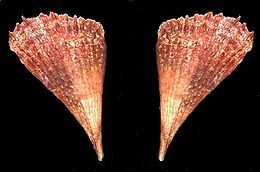Pinna carnea
| Pinna carnea | |
|---|---|
 | |
| Scientific classification | |
| Kingdom: | Animalia |
| Phylum: | Mollusca |
| Class: | Bivalvia |
| Order: | Pterioida |
| Family: | Pinnidae |
| Genus: | Pinna |
| Species: | P. carnea |
| Binomial name | |
| Pinna carnea Gmelin, 1791 [1] | |
| Synonyms[1] | |
| |
Pinna carnea, or the amber pen shell, is a species of bivalve mollusc in the family Pinnidae. It can be found in Caribbean waters, ranging from southern Florida to the West Indies and Bermuda.[2][3][4]
Description
The amber pen shell has a pair of long, thin translucent valves and is triangular, fan or wedge–shaped, with a point at one end and a curved ragged end at the other extremity. It is hinged along the long straight side. It can grow to about 40 centimetres (16 in) long though it is usually smaller than this. It has several low ribs radiating from the pointed end and running the length of the valve. The colour is a dull orange externally but the inside of the shell is iridescent. The amber pen shell lives with the pointed end and majority of its shell buried in soft sediment and anchored to rock or firm sediment by a web of byssus threads. As it grows it can use these threads and its retractor muscle to burrow deeper into the sediment. Only a few centimetres are exposed above the seabed.[5][6]
Distribution and habitat
The amber pen shell occurs in southern Florida, Texas and Bermuda, the Caribbean Sea and south to Brazil. Its habitat is sand, gravel, muddy sand or seagrass meadow at depths between 2 and 15 metres (6 ft 7 in and 49 ft 3 in). Algae and marine invertebrates tend to grow on the exposed part of the shell, often making it nearly invisible. Sometimes the larva settles on a vertical reef face and grows out horizontally. Here it is much more exposed to wave action and may be colonised by the tree oyster (Isognomon).[7]
Biology
The amber pen shell is a filter feeder. Water is drawn into the shell from above and passed over the ctenidium before being expelled into the open water at the exposed part of the shell. This avoids the gills getting clogged with sediment. In this process, oxygen is absorbed and food particles captured and transferred to the mouth in balls of mucous. If the shell gets damaged, it can be repaired by the laying down of further calcareous material.[8]
The amber pen shell is a hermaphrodite, the gonads producing both sperm and ova. The larvae are planktonic and drift with the currents. When they settle on the seabed they undergo metamorphosis into juvenile bivalves. These normally then remain in the same spot for the rest of their lives though it is possible for a shell that has been uprooted in a storm to dig itself in again elsewhere.[6][8]
References
- ↑ 1.0 1.1 WoRMS (2010). "Pinna carnea Gmelin, 1791". World Register of Marine Species. Retrieved 2012-09-11.
- ↑ Abbott, R.T. & Morris, P.A. A Field Guide to Shells: Atlantic and Gulf Coasts and the West Indies. New York: Houghton Mifflin, 1995. 23.
- ↑ Lodeiros, Cesar., Marín, Baumar. y Prieto, Antulio 1999: Catálogo de moluscos marinos de las costas nororientales de Venezuela: Clase Bivalvia. Asociación de Profesores de la Universidad de Oriente. Cumaná - Venezuela. Pp:25.
- ↑ Macsotay, O. & R. Campos. 2001. Moluscos representativos de la plataforma de Margarita, Venezuela. Editora Rivolta. Valencia, Venezuela, 279 pp. ISBN 980-328-808-3
- ↑ Colin, Patrick L. (1978). Marine Invertebrates and Plants of the Living Reef. T.F.H. Publications. p. 387. ISBN 0-86622-875-6.
- ↑ 6.0 6.1 Becker, Cassandra. "Amber Pen Shell (Pinna carnea)". Marine Invertebrates of Bermuda. Retrieved 2012-09-11.
- ↑ "Amber penshell (Pinna carnea)". Interactive Guide to Caribbean Diving. Marine Species Identification Portal. Retrieved 2012-09-11.
- ↑ 8.0 8.1 Yonge, C. M. (1953). "Form and Habit in Pinna carnea Gmelin". Philosophical Transactions of the Royal Society of London. Series B, Biological Sciences 237 (648): 335–374. doi:10.1098/rstb.1953.0006. JSTOR 92484.